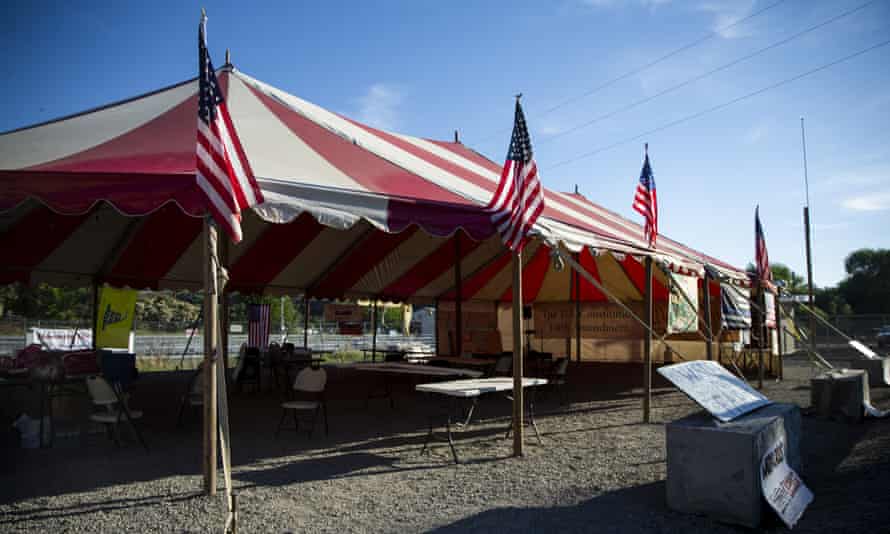Fears of a confrontation between law enforcement and rightwing militia supporters over the control of water in the drought-stricken American west have been sparked by protests at Klamath Falls in Oregon.
Protesters affiliated with rightwing anti-government activist Ammon Bundy’s People’s Rights Network are threatening to break a deadlock over water management in the area by unilaterally opening the headgates of a reservoir.
The protest has reawakened memories not only of recent standoffs with federal agencies – including the one led by Bundy in eastern Oregon in 2016 – but a longer history of anti-government agitation in southern Oregon and northern California, stretching back to 2000 and beyond.
The area is a hotbed of militia and anti-government activity and also hit by the mega-drought that has struck the American west and caused turmoil in the agricultural community as conflicts over water become more intense. Among the current protesters at Klamath Falls are individuals who have themselves been involved in similar actions over two decades, including an illegal release of water at the same reservoir in 2001.
In May, the federal Bureau of Reclamation announced that there would be no further release of water from the reserves in the Klamath Basin for irrigators downstream, who rely on the Klamath Project water infrastructure along the Oregon-California border.
Later in the month, two Oregon irrigators, Grant Knoll and Dan Neilsen, began occupying a piece of land adjacent to the headgates of the main canal which pipes water to downstream farmers and Native American tribal groups, like the Yurok, who depend on the water “flushing” the river for the benefit of salmon hatchlings.
Knoll and Nielsen, along with members of the People’s Rights Network, which has engaged in militant anti-mask protests in neighboring Idaho, began staffing a tent on the property which they dubbed a “water crisis info center”.

They also told a number of media outlets that they were prepared to restore the flow of water, even at the price of a confrontation with the federal government, with Knoll telling Jefferson Public Radio last Monday: “We’re going to turn on the water and have a standoff.”
Also on the property is a large metal bucket, daubed with anti-government slogans, which is a memento of a 2001 confrontation at the same spot. That July, 100 farmers, including Knoll and Nielsen, used an 8in-wide irrigation line to bypass the headgate, sending water down the canal. That year, the action by the farmers was followed by other protest actions, such as an American flag-bedecked horse charge, similar to the one that took place on the Bundy ranch during that family’s standoff with federal authorities in 2014.
The confrontation was only defused after appeals were made to the farmers in the wake of the World Trade Center attacks on September 11.
Then as now, the reduced flows were partly with environmental issues in mind.
This year, amid the severe drought, the measure is being taken in accordance with the Endangered Species Act, to ensure the survival of two species of suckerfish whose last remaining habitats are in the reservoirs.
In order to keep enough water in the system to ensure their survival, water must be denied to those who rely on it downstream, including both farmers and tribes who depend on fishing.
Endangered Coho Salmon will likely suffer from the lack of water, along with migrating birds later in the season whose refuges have dried up. But previous court decisions have determined that the interests of those upstream should take precedence, including the Klamath Tribes, for whom the suckerfish have a spiritual significance.
While the protesters claim to represent the interests of farmers, they have been disavowed by agricultural leaders, including Ben DuVal, president of the Klamath Water Users Association, who told the Sacramento Bee that the protesters were “idiots who have no business being here”, who were using the crisis as “a soapbox to push their agenda”.
Whether or not DuVal speaks for the majority of farmers, there is no sign that the so far small protest is catching on like 2001’s anti-government surge, which saw protest crowds in the thousands in the lead up to the breaching of the headgates.
And while the protesters’ placards promise “Ammon Bundy coming soon”, their leader has so far not made the trip to the Klamath camp from neighboring Idaho, where he recently filed to run for governor.